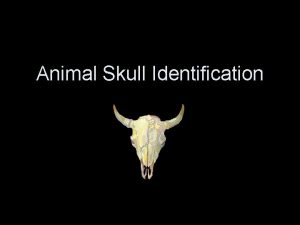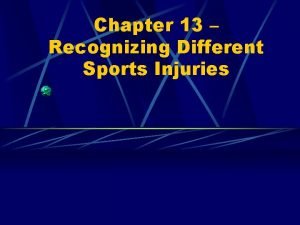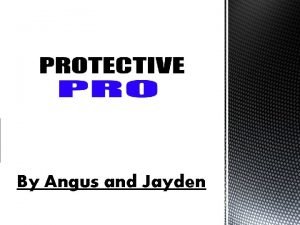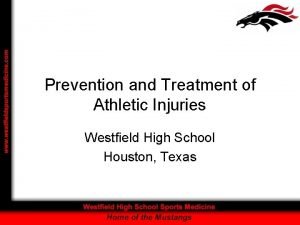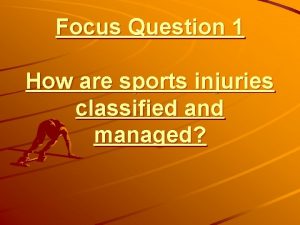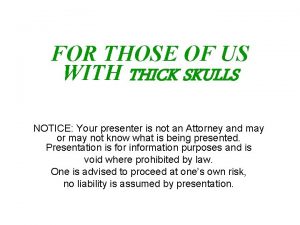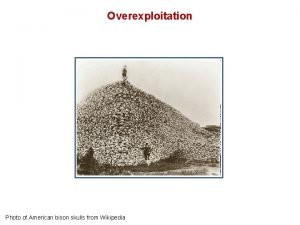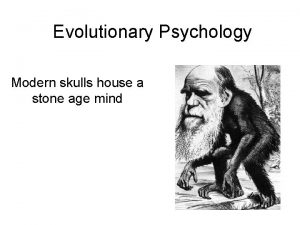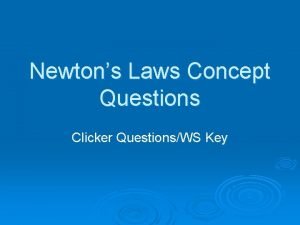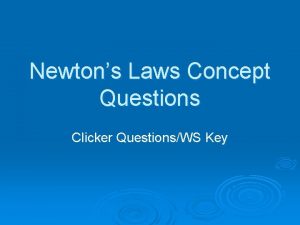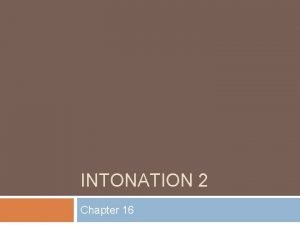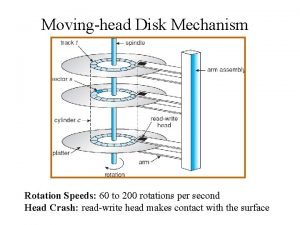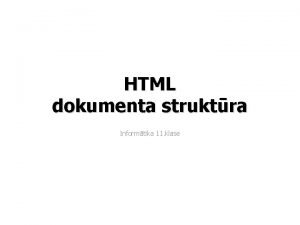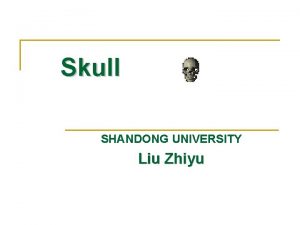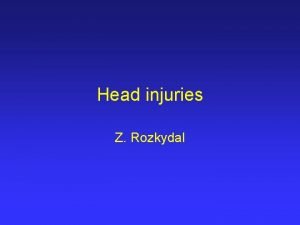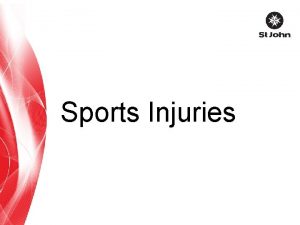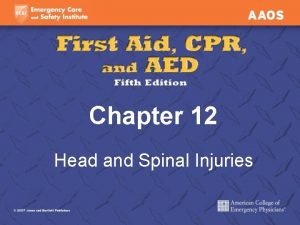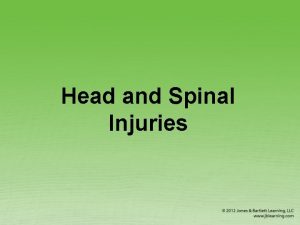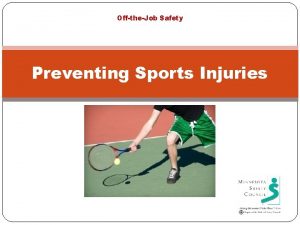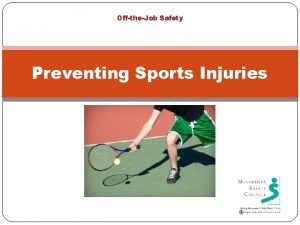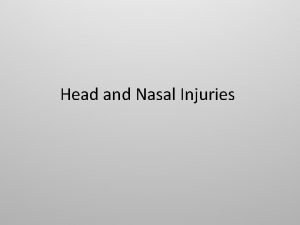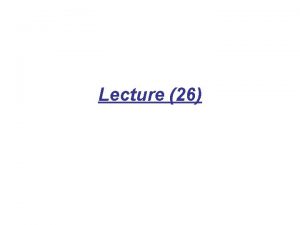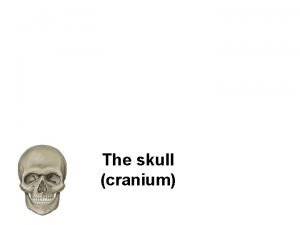Head Injuries in Sports Skull Facts The skulls























- Slides: 23

Head Injuries in Sports

Skull Facts The skull’s primary job is to protect the brain from injury. n 28 bones make up the skull. n Sutures- the spaces between the bones of the skull. These spaces are movable at birth and begin to close up as the person grows. n

Scalp Absorbs energy in an effort to protect the bones of the skull. n Skull fractures would occur with significantly less force without the presence of the scalp. n Highly vascularized skin and soft tissue. Bleeds profusely when lacerated. n

The Human Brain n n Made up of billions of cells. Weighs approximately 3 pounds. Uses 15% of blood supply. Requires 20% of total body oxygen. n Brain cells grow and develop until 18 years of age. After which brain cells can be destroyed but not reproduced.

Lobes of the Brain n n The brain is divided into sections called lobes. Each lobe of the brain is responsible for various body functions. n 1. 2. 3. 4. Lobes Occipital- posterior Parietal- sides Temporal-sides anterior Frontal- anterior

Skull Fractures Comminuted Fracture Depressed Skull Fracture Basilar Skull Fx Linear Skull Fracture

Raccoon Eyes n n Visible sign of skull fracture Delayed discoloration around the eyes. From anterior cranial fracture.

Battle’s Sign n n A discoloration that can appear within minutes behind the ear. Indicative of a basilar fracture. Blood or cerebrospinal fluid may leak from the ear canal.

Skull Fracture Treatment n n If bleeding do not attempt to restrict blood flow for this may increase intracranial pressure. Do not apply pressure to the area, cover wounds with sterile dressing. Monitor vital signs.

Epidural Hematoma n n Bleeding between dura mater and skull. Rapid Arterial Bleeding Signs and symptoms will appear within 10 -20 minutes. Immediate surgery to drill hole and decompress the hematoma and control bleeding.

Subdural Hematoma n n n Bleeding between dura mater and brain. Slow venous bleeding. Low pressure bleedinghematoma forms slowly. Signs and symptoms may not be apparent for hours, days, or weeks. Most prevalent cause of death in sports!

Concussion Facts n n n Referred to as a Mild Traumatic Brain Injury Defined as: a disturbance in the function of the nervous system resulting from a bump, blow, or jolt to the head. Impairment of Functions 1. 2. 3. 4. Alteration of consciousness Disturbance of vision Disturbance of equilibrium Decrease in cognitive function

Concussion Facts II Does not necessarily result in Loss of Consciousness. n Severity of concussions range from mild to moderate to severe. n Duration of symptoms last from several minutes, to days, to months, to even longer. n

Signs Observed by Athletic Trainer or Coach n n n Appears dazed or stunned Is confused about assignment Forgets plays Is unsure of game, score, or opponent Moves clumsily n n n Loses consciousness Answers questions slowly Shows behavior or personality changes Can’t recall events prior to hit Can’t recall events after hit

Symptoms Reported by Athlete n n n Headache Nausea Balance problems or dizziness Double or fuzzy vision Sensitivity to light or noise n n Feeling sluggish Feeling foggy or groggy Concentration or memory problems Confusion

Second Impact Syndrome n An individual sustains a head injury, then sustains a 2 nd head injury before the symptoms of the first have totally resolved. n n Involves rapid brain swelling. Brainstem failure occurs within 2 -5 minutes. 1. 2. 3. 4. Dilated pupils Loss of eye movement Respiratory failure Coma

Coup and Contrecoup Injury Contrecoup- contusion of the brain can occur from a shaking or jolting of the brain within the confines of the skull. n Coup- contusion occurs at the same side as the point of impact. n

Gradual Return to Play Guidelines n n n Remove from activity if any signs or symptoms of concussion are present. The athlete will be allowed to slowly return to play following a 6 step progression. If symptoms return during any of the steps the athlete returns to step 1.

Step 1 n No physical activity until concussion symptoms resolve.

Step 2 Low levels of physical activity. n Light jogging n Stationary bike n Light weight training n

Step 3 Moderate levels of physical activity with body/ head movement. n Moderate weightlifting. n Moderate jogging, brief running. n

Step 4 Heavy non-contact physical activity. n Regular weight training routine. n Sprinting n Sport-specific non-contact drills. n

Steps 5 & 6 n Step 5 - Full contact in controlled practice. n Step 6 - Full contact in game play.
 Sugar skulls facts
Sugar skulls facts Carnivore skull characteristics
Carnivore skull characteristics Chapter 11 assessment and evaluation of sports injuries
Chapter 11 assessment and evaluation of sports injuries Chapter 13 worksheet recognizing different sports injuries
Chapter 13 worksheet recognizing different sports injuries Sports injuries angus, on
Sports injuries angus, on Westfield sports injuries
Westfield sports injuries How are sports injuries classified and managed
How are sports injuries classified and managed Chapter 28 head and spine injuries
Chapter 28 head and spine injuries Chapter 21 caring for head and spine injuries
Chapter 21 caring for head and spine injuries For those of us with thick skulls
For those of us with thick skulls Maximum sustainable yield
Maximum sustainable yield Our modern skulls house a stone age mind
Our modern skulls house a stone age mind The fourth little pig's house was made of wolf skulls
The fourth little pig's house was made of wolf skulls Difference between male and female skulls
Difference between male and female skulls Sloping frontal bone
Sloping frontal bone Outdoor sports chart
Outdoor sports chart Henrys tires
Henrys tires A small sports car collides head on with a massive truck
A small sports car collides head on with a massive truck Neck part of body
Neck part of body The tone unit
The tone unit The attacking firm goes head-to-head with its competitor.
The attacking firm goes head-to-head with its competitor. What is tonic syllable
What is tonic syllable The head of moving head disk with 100 tracks
The head of moving head disk with 100 tracks Tagi html
Tagi html

